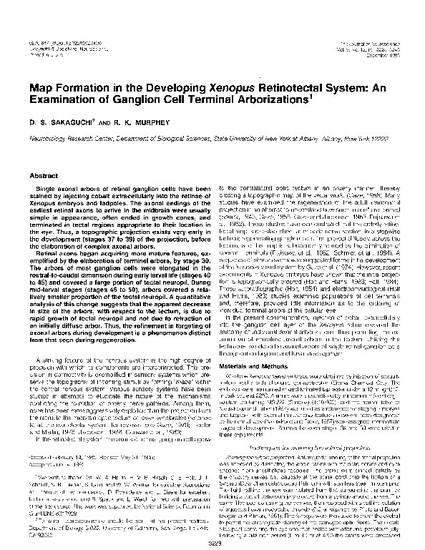
Article
Map formation in the developing Xenopus retinotectal system: an examination of ganglion cell terminal arborizations
The Journal of Neuroscience
(1985)
Abstract
Single axonal arbors of retinal ganglion cells have been stained by injecting cobalt extracellularly into the retinae of Xenopus embryos and tadpoles. The axonal endings of the earliest retinal axons to arrive in the midbrain were usually simple in appearance, often ended in growth cones, and terminated in tectal regions appropriate to their location in the eye. Thus, a topographic projection exists very early in the development (stages 37 to 39) of the projection, before the elaboration of complex axonal arbors. Retinal axons began acquiring more mature features, exemplified by the elaboration of terminal arbors, by stage 39. The arbors of most ganglion cells were elongated in the rostral-to-caudal dimension during early larval life (stages 40 to 45) and covered a large portion of tectal neuropil. During mid-larval stages (stages 46 to 50), arbors covered a relatively smaller proportion of the tectal neuropil. A quantitative analysis of this change suggests that the apparent decrease in size of the arbors, with respect to the tectum, is due to rapid growth of tectal neuropil and not due to retraction of an initially diffuse arbor. Thus, the refinement in targeting of axonal arbors during development is a phenomenon distinct from that seen during regeneration.
Disciplines
Publication Date
December, 1985
Publisher Statement
Copyright 1985 Society of Neuroscience
Citation Information
D. S. Sakaguchi and R. K. Murphey. "Map formation in the developing Xenopus retinotectal system: an examination of ganglion cell terminal arborizations" The Journal of Neuroscience Vol. 5 Iss. 12 (1985) p. 3228 - 3245 Available at: http://works.bepress.com/donald-sakaguchi/12/
Creative Commons license

This work is licensed under a Creative Commons CC_BY International License.
